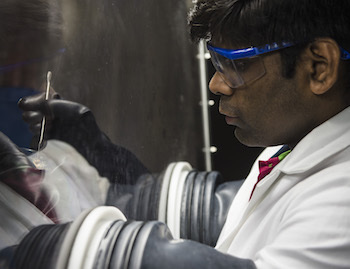Clay-based batteries for harsh environments

Researchers at Rice and Wayne State University have developed materials, including a clay-based electrolyte, that would supply stable electrochemical power in temperatures up to 120°C. Such clay-based batteries could find use in space, defence and oil and gas applications, among others.
“Clay naturally has a lot of moisture in it, and that’s not a problem when you’re doing supercapacitors. But a battery has to have a lithium-ion conductive species in the electrolyte to conduct lithium ions from the cathode or anode, or vice versa, when you charge and discharge,” said Kaushik Kalaga, a graduate student in Chemist Pulickel Ajayan’s lab and lead author of the new study. “Lithium is very reactive with water, so our first challenge was to eliminate water from the clay while keeping its structure intact,” he said.
Kalaga and his team started by baking commercial clay particles at 650°C for an hour to dry them out. They then combined a room-temperature ionic liquid and lithium salt and mixed them into the clay in an oxygen-free glove box. The liquefied salt acts as a source of lithium ions that conduct through the electrolyte to the electrodes.
The researchers spread the resulting peanut butter-like slurry between lithium metal electrodes and encapsulated them in coin-shaped batteries for testing at various temperatures. Conventional organic electrolytes cannot be used in batteries over 60°C, due to their low boiling temperature; the vapours that form beyond 80°C can lead to an explosion, Kalaga said.
Batteries that have solid-state electrolytes work in high temperatures, but the electrolytes don’t connect as well with electrodes, which hurts performance. The researchers built their composite electrolyte to be tough and conductive and still present the maximum surface area to electrodes to provide a solid path for current.
The units proved able to deliver current at high temperatures with a stable voltage window of 3 volts over 120 charge-discharge cycles and featured both the thermal stability of solid-state electrolytes and the wetting properties of liquid electrolytes, assuring good contact with the electrodes. The voltage window is the range between which the electrolyte is stable and is not chemically degraded.
“It’s able to produce pretty good performance at room temperature, but it gets better at higher temperatures,” Kalaga said. “The clay-based electrolyte gets less viscous but still retains its consistency at least to 150°C. The next step is to push the limits further.”
The nature of the material makes it suitable for forming into many types of batteries, from thin films to commercial-scale units, according to the researchers. “There are many applications that need energy storage devices to work in extreme environments, and there needs to be innovation in the materials systems, particularly electrolytes, to expand the window of operation conditions,” Ajayan said.
Computational model enhances battery safety
Researchers have developed a new computational model that offers insights into one of the key...
Novel method to extend lifecycle of Li-ion batteries
Researchers have uncovered a hidden surface degradation mechanism in the cathodes of lithium-ion...
Sensor could help prevent Li-ion battery fires
Researchers have developed new technology to detect dangerous gas leaks in lithium-ion batteries,...





